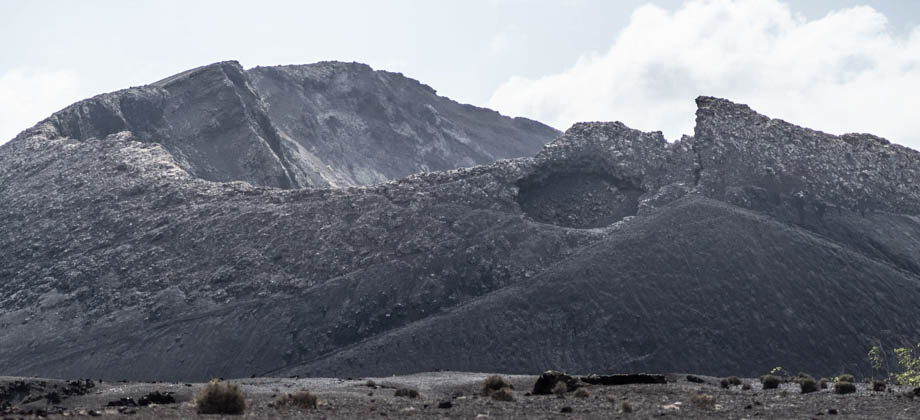September 1, 2019
Posted by
Ramon Fadli in
Arid Desert,
Astronomy,
Canary Islands,
Class 4,
Day Hike,
Hiking,
Islands,
IUCN Protected Category 2,
Looped Hike,
National Parks,
Sclerophyll & Mediterranean Forests,
Spain,
Sunrise & Sunset,
UNESCO,
Volcanoes Caldera Blanca
Flora & Fauna
The almost non-existence of soil and water makes it very difficult for vegetation to colonise the barren malpais. The lack of rainfall also brings erosive processes, which are needed for the development of fertile soil, to a slow crawl. Lichens, on the other hand, help with soil formation and are essential to 'restart' the process of vegetative colonialisation in barren areas, due to their adaptability and survivability. I elaborated a little further in one of my
Annapurna Base Camp posts:
Lichen are a product of the symbiosis of fungus, which gives the lichen its form, and either algae or cyanobacterium, which gives the lichen the ability to photosynthesise. This consolidation is quite powerful, as the new 'composite' which behaves as a single individual is now able to receive nutrients from photosynthesis, and is hardy enough to resist dangers such as exposure to ultraviolet radiation, which tends to increase with elevation.
Lichens are very sensitive to their surrounding environments, however, which can make them good indicators when trying to access how well a specific area has been conserved. This is also why hikers should always remain on the trails, as a footstep on a patch of lichen can sometimes still be observed many years later.
 Firedot lichen (Caloplaca sp.); Bushy lichen (Ramalina sp.), a type of fruticose lichen
Firedot lichen (Caloplaca sp.); Bushy lichen (Ramalina sp.), a type of fruticose lichen
Before this point, lichens had been the dominant life-form, but as we began to circle around the sides of the caldereta, we noticed that shrubs and other vegetation were concentrated in an area that formed a large ring around the base. This is because the shape of craters channel rainfall both into the interior as well as outwards towards the base of their slopes. The accumulation of rainfall, especially in environments where rainfall is scarce, as well as the sedimentation that the water flow picks up, helps with the formulation of fertile soil. In fact, the interior of the caldereta used to be used for cereal cultivation, which is why there are several abandoned structures nearby.

 African baconfig (Aizoon canariense), top; Asteriscus intermedius, lower left, whichis native to the Canary Islands; a century plant (Agave americana), lower right
African baconfig (Aizoon canariense), top; Asteriscus intermedius, lower left, whichis native to the Canary Islands; a century plant (Agave americana), lower right
The shrubs that we came across varied both in size and in colour. There were red plants, such as Mediterranean saltwort
(Salsola vermiculata) bushes and slender iceplant
(Mesembryanthemum nodiflorum) succulents, to yellow flowering plants such as
Launaea arborescens, which is from the dandelion family, and tree tobacco
(Nicotiana glauca), which is a species of wild tobacco.
Tree tobacco is not only smoked (by Native American communities like the Cahuilla for instance), but is also known to have been used for medicinal purposes as a poultice for superficial wounds like cuts and bruises. The plant is toxic and ingestion can sometimes be fatal. Another flowering plant that was spotted that has medicinal properties was the
Heliotropium ramosissimum. In parts of Africa, the sap from their furry leaves is said to be good for burns and as a topical ointment to treat headaches.
The largest plants that we saw were the strange root-like branches of the milky spurge
(Euphorbia regis-jubae). This flowering plant is endemic to the Eastern Canary Islands, Morocco, and Western Sahara, where the plant's toxic latex is used as an analgesic. In the Canary Islands, the latex used to be poured into pools of fish (a process that is called 'embarbascar' in Spanish), in order to stupefy them so that they would be easier to catch. We were also fortunate to see the plant's fruiting heads ('Infructescence'), which were reddish trilobed capsules that emerged from greenish-yellow floral bracts.
 Milky Spurge (Euphorbia regis-jubae) with corticolous lichens growing on its
Milky Spurge (Euphorbia regis-jubae) with corticolous lichens growing on its
stems - Hover the cursor over the image to take a closer look; Montaña de
Teneza can be seen in the background on the top left of the image
 The trilobed fruit capsules of milky Spurge (Euphorbia regis-jubae) with a snail (Theba geminata)
The trilobed fruit capsules of milky Spurge (Euphorbia regis-jubae) with a snail (Theba geminata)



























